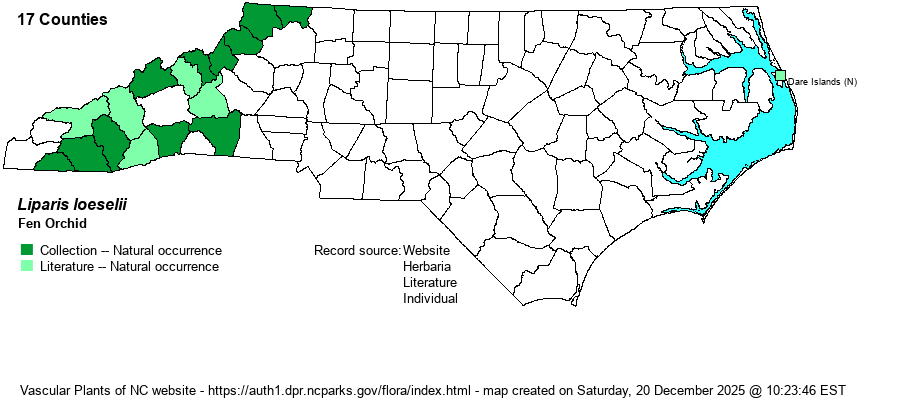| Author | (L.) L.C. Richard | |
| Distribution | Scattered over most of the Mountains. Seemingly absent elsewhere in the state, except for a greatly disjunct record to the Outer Banks of northern Dare County (Nags Head Woods, last seen 1988).
This is a wide-ranging Northern species occurring across much of southern Canada, ranging south to eastern NC, the mountains of southwestern NC, sparingly into AL, and AR. It is scarce in most of the eastern states south of PA and IA, with most records being in the Appalachians.
| |
| Abundance | Very rare to rare in the Mountains. Absent downstate, except at one site on the Dare County barrier island. Though there are records apparently for 17 mountain/foothills counties, there are barely one or two records for each county, and many records are now likely historical. As a result, the NC NHP has given it a state rank of S1, and it has a legal state status of Endangered. | |
| Habitat | This is a species of small isolated wet places, most frequently found in wooded seeps at moderate to high elevations. It can also occur in wet meadows or other damp ground over mafic rocks, very rare conditions. On the Outer Banks, it is found in a "mucky bay swamp" (Weakley 2018), but called a "freshwater seepage swamp" by Sorrie (in prep.). This orchid thus occurs on higher pH soil conditions than most others in the family. | |
| Phenology | Blooms and fruits from May to July. | |
| Identification | Though reported from the great majority of the NC mountain counties, few biologists have encountered this elusive species. It has two large basal leaves, somewhat yellow-green in color, elliptical, entire, and shiny, growing to about 4-6 inches long. Unlike with L. liliifolia, which has rounded leaves that grow close to the ground or somewhat angled upward, these leaves are narrower and are strongly angled upward, at least at a 45-degree angle to the stem. The flowering stem reaches only about 6-8 inches tall, topped by a loose raceme of about 8-10 light yellow or light greenish-yellow flowers, not too different in color from the rest of the plant. Each flower is about 1/2-inch across and has narrow linear sepals and petals. In NC, it seldom grows in moderate or large populations; rather only a few plants are reported at most locations, though a very few sites have had 30 or more plants. Good luck searching for this rarity! | |
| Taxonomic Comments | None
| |
| Other Common Name(s) | Loesel's Twayblade, Yellow Widelip Orchid, Loesel's Widelip Orchid | |
| State Rank | S1 | |
| Global Rank | G5 | |
| State Status | E | |
| US Status | | |
| USACE-agcp | FACW link |
| USACE-emp | FACW link |

